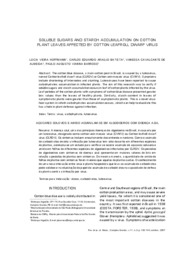Soluble sugars and starch accumulation on cotton plant leaves affected by cotton leafroll dwarf virus.
Soluble sugars and starch accumulation on cotton plant leaves affected by cotton leafroll dwarf virus.
Author(s): HOFFMAN, L. V.; BATISTA, C. E. de A.; ALMEIDA, V. C. de; BARROSO, P. A. V.
Summary: The cotton blue disease, a main cotton pest in Brazil, is caused by a luteovirus, named Cotton leafroll dwarf virus (CLRDV) or Cotton vein mosaic virus (CVMV). Symptoms include shortening of internodes and stunting. Luteoviruses have been reported to cause carbohydrates accumulation in infected plants. The aim of this research was to verify if soluble sugars and starch accumulation occurs in leaf of cotton plants infected by the virus. Leaf petioles of the cotton plants with symptoms of cotton blue disease presented greater brix values than the leaves of healthy plants. Similarly, starch content in leaves of symptomatic plants were greater than those of asymptomatic plants. This is a novel virus- host system in which carbohydrates accumulation occurs, which can help to elucidate this has a hole in plant defense against infection.
Publication year: 2007
Types of publication: Journal article
Unit: Embrapa Cotton
Keywords: Carbohydrate, Luteovirus, Vírus
Observation
Some of Embrapa's publications are published as ePub files. To read them, use or download one of the following free software options to your computer or mobile device. Android: Google Play Books; IOS: iBooks; Windows and Linux: Calibre.
Access other publications
Access the Agricultural Research Database (BDPA) to consult Embrapa's full library collection and records.
Visit Embrapa Bookstore to purchase books and other publications sold by Embrapa.

